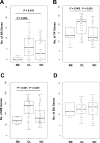Genomic Features and Niche-Adaptation of Enterococcus faecium Strains from Korean Soybean-Fermented Foods
- PMID: 27070419
- PMCID: PMC4829236
- DOI: 10.1371/journal.pone.0153279
Genomic Features and Niche-Adaptation of Enterococcus faecium Strains from Korean Soybean-Fermented Foods
Abstract
Certain strains of Enterococcus faecium contribute beneficially to human health and food fermentation. However, other E. faecium strains are opportunistic pathogens due to the acquisition of virulence factors and antibiotic resistance determinants. To characterize E. faecium from soybean fermentation, we sequenced the genomes of 10 E. faecium strains from Korean soybean-fermented foods and analyzed their genomes by comparing them with 51 clinical and 52 non-clinical strains of different origins. Hierarchical clustering based on 13,820 orthologous genes from all E. faecium genomes showed that the 10 strains are distinguished from most of the clinical strains. Like non-clinical strains, their genomes are significantly smaller than clinical strains due to fewer accessory genes associated with antibiotic resistance, virulence, and mobile genetic elements. Moreover, we identified niche-associated gene gain and loss from the soybean strains. Thus, we conclude that soybean E. faecium strains might have evolved to have distinctive genomic features that may contribute to its ability to thrive during soybean fermentation.
Conflict of interest statement
Figures






Similar articles
-
Virulence genes, antibiotic resistance and plasmid profiles of Enterococcus faecalis and Enterococcus faecium from naturally fermented Turkish foods.J Appl Microbiol. 2010 Sep;109(3):1084-92. doi: 10.1111/j.1365-2672.2010.04763.x. J Appl Microbiol. 2010. PMID: 20497489
-
Nonclinical and clinical Enterococcus faecium strains, but not Enterococcus faecalis strains, have distinct structural and functional genomic features.Appl Environ Microbiol. 2014 Jan;80(1):154-65. doi: 10.1128/AEM.03108-13. Epub 2013 Oct 18. Appl Environ Microbiol. 2014. PMID: 24141120 Free PMC article.
-
Phenotypic and molecular antibiotic resistance profile of Enterococcus faecalis and Enterococcus faecium isolated from different traditional fermented foods.Foodborne Pathog Dis. 2013 Feb;10(2):143-9. doi: 10.1089/fpd.2012.1279. Epub 2012 Dec 21. Foodborne Pathog Dis. 2013. PMID: 23259502
-
Current Perspectives on the Physiological Activities of Fermented Soybean-Derived Cheonggukjang.Int J Mol Sci. 2021 May 27;22(11):5746. doi: 10.3390/ijms22115746. Int J Mol Sci. 2021. PMID: 34072216 Free PMC article. Review.
-
Genomic and functional features of yeast species in Korean traditional fermented alcoholic beverage and soybean products.FEMS Yeast Res. 2023 Jan 4;23:foac066. doi: 10.1093/femsyr/foac066. FEMS Yeast Res. 2023. PMID: 36564017 Review.
Cited by
-
Genome and transcriptome analysis of Enterococcus faecium from intestinal colonization and Enterococcus faecium from urinary tract infection.Front Microbiol. 2023 Oct 31;14:1273949. doi: 10.3389/fmicb.2023.1273949. eCollection 2023. Front Microbiol. 2023. PMID: 38029192 Free PMC article.
-
Genetic diversity and distinction of Enterococcus faecium and Enterococcus lactis in traditional Montenegrin brine cheeses and salamis.Front Microbiol. 2024 Dec 11;15:1473938. doi: 10.3389/fmicb.2024.1473938. eCollection 2024. Front Microbiol. 2024. PMID: 39723131 Free PMC article.
-
New Insight into Bacterial Interaction with the Matrix of Plant-Based Fermented Foods.Foods. 2021 Jul 10;10(7):1603. doi: 10.3390/foods10071603. Foods. 2021. PMID: 34359473 Free PMC article. Review.
-
Comparative Analysis of Lactobacillus gasseri and Lactobacillus crispatus Isolated From Human Urogenital and Gastrointestinal Tracts.Front Microbiol. 2020 Jan 22;10:3146. doi: 10.3389/fmicb.2019.03146. eCollection 2019. Front Microbiol. 2020. PMID: 32038579 Free PMC article.
-
Genome-based species-specific primers for rapid identification of six species of Lactobacillus acidophilus group using multiplex PCR.PLoS One. 2020 Mar 20;15(3):e0230550. doi: 10.1371/journal.pone.0230550. eCollection 2020. PLoS One. 2020. PMID: 32196527 Free PMC article.
References
-
- Jeong DW, Kim HR, Jung G, Han S, Kim CT, Lee JH Bacterial community migration in the ripening of doenjang, a traditional Korean fermented soybean food. J Microbiol Biotechnol. 2014; 24(5): 648–660. - PubMed
-
- Castillo-Rojas G, Mazari-Hiríart M, Ponce de León S, Amieva-Fernández RI, Agis-Juárez RA, Huebner J, et al. Comparison of Enterococcus faecium and Enterococcus faecalis strains isolated from water and clinical samples: Antimicrobial susceptibility and genetic relationships. PLoS One. 2013; 8(4): e59491 10.1371/journal.pone.0059491 - DOI - PMC - PubMed
Publication types
MeSH terms
LinkOut - more resources
Full Text Sources
Other Literature Sources

